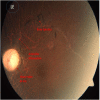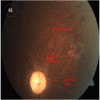Bardet-Biedl syndrome: multiple fingers with multiple defects!
- PMID: 26611481
- PMCID: PMC4680628
- DOI: 10.1136/bcr-2015-211776
Bardet-Biedl syndrome: multiple fingers with multiple defects!
Abstract
Bardet-Biedl syndrome (BBS) is a rare congenital ciliopathy characterised by rod-cone dystrophy, postaxial polydactyly, central obesity, mental retardation, hypogonadism and renal dysfunction. A 45-year-old Indian man presented with New York Heart Association class 2 dyspnoea of 3 months duration. He was blind since childhood. He was obese, cyanosed, and had clubbing and polydactyly. Systemic examination revealed presence of wide and fixed split second heart sound with systolic murmur in the left parasternal area. Work up unmasked the presence of secondary polycythaemia, atypical retinitis pigmentosa and partial atrioventricular defect. He was diagnosed to have BBS based on clinical and radiological features. This case is interesting for its rarity and also for the peculiarity of its cardiovascular association. Polydactyly with a suspicious clinical background is the clue and by itself warrants the clinician to search for occult anomalies. Clinicians must be aware of this syndrome, for which an early diagnosis and a multidisciplinary approach will significantly improve mortality and morbidity in patients.
2015 BMJ Publishing Group Ltd.
Figures




References
Publication types
MeSH terms
LinkOut - more resources
Full Text Sources
Other Literature Sources
